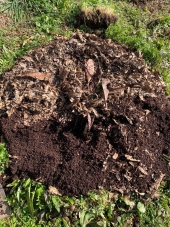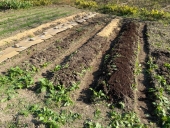Hello, I'm a newbie to growing plants. My focus has been on improving soil health and making compost.
I live in Kochi, Japan.
I am volunteering to build a garden at an elementary school.
The field is clay and has poor drainage.
So I had to start from the beginning by tilling everything.
Then in the late fall made beds and furrows to improve drainage.
My plan is to add organic matter.
Some rows have cover crops of winter rye and hairy vetch.
Some are covered with mulch. Some have compost. I even added a little biochar. (I plan to make more.)
Next to the rows I will make a "chaos" garden. Mix in compost and then throw in a diversity of seeds: grasses, wildflowers and vegetables.
Next to that I plan to grow tall grasses to be used as mulch over the summer.
The school has many resources, locally we can get free composted cow manure (I need to find out what they feed the cows), wood chips and rice hulls.
We already have a compost pile. In the spring, we will plant vegetables, but I'm not expecting a good result because the soil is not yet ready.
We will try different natural fertilizers like fermented fish. I expect it will take 3 years to get healthy soil.
With this community garden, I want to show people what healthy soil looks like. I hope we can start urban gardens in unused space in Kochi City.
I also want to start a meadow. But I'm not sure how that will work out because the nature here wants to be a lush forest. I understand that meadows
grow in drier conditions. I can't wait for spring!
Any feedback is appreciated.









